Interventions to improve sanitation for preventing diarrhoea
- PMID: 36697370
- PMCID: PMC9969045
- DOI: 10.1002/14651858.CD013328.pub2
Interventions to improve sanitation for preventing diarrhoea
Abstract
Background: Diarrhoea is a major contributor to the global disease burden, particularly amongst children under five years in low- and middle-income countries (LMICs). As many of the infectious agents associated with diarrhoea are transmitted through faeces, sanitation interventions to safely contain and manage human faeces have the potential to reduce exposure and diarrhoeal disease.
Objectives: To assess the effectiveness of sanitation interventions for preventing diarrhoeal disease, alone or in combination with other WASH interventions.
Search methods: We searched the Cochrane Infectious Diseases Group Specialized Register, CENTRAL, MEDLINE, Embase, LILACS, and Chinese language databases available under the China National Knowledge Infrastructure (CNKI-CAJ). We also searched the metaRegister of Controlled Trials (mRCT) and conference proceedings, contacted researchers, and searched references of included studies. The last search date was 16 February 2022.
Selection criteria: We included randomized controlled trials (RCTs), quasi-RCTs, non-randomized controlled trials (NRCTs), controlled before-and-after studies (CBAs), and matched cohort studies of interventions aimed at introducing or expanding the coverage and/or use of sanitation facilities in children and adults in any country or population. Our primary outcome of interest was diarrhoea and secondary outcomes included dysentery (bloody diarrhoea), persistent diarrhoea, hospital or clinical visits for diarrhoea, mortality, and adverse events. We included sanitation interventions whether they were conducted independently or in combination with other interventions.
Data collection and analysis: Two review authors independently assessed eligible studies, extracted relevant data, assessed risk of bias, and assessed the certainty of evidence using the GRADE approach. We used meta-analyses to estimate pooled measures of effect, described results narratively, and investigated potential sources of heterogeneity using subgroup analyses.
Main results: Fifty-one studies met our inclusion criteria, with a total of 238,535 participants. Of these, 50 studies had sufficient information to be included in quantitative meta-analysis, including 17 cluster-RCTs and 33 studies with non-randomized study designs (20 NRCTs, one CBA, and 12 matched cohort studies). Most were conducted in LMICs and 86% were conducted in whole or part in rural areas. Studies covered three broad types of interventions: (1) providing access to any sanitation facility to participants without existing access practising open defecation, (2) improving participants' existing sanitation facility, or (3) behaviour change messaging to improve sanitation access or practices without providing hardware or subsidy, although many studies overlapped multiple categories. There was substantial heterogeneity amongst individual study results for all types of interventions. Providing access to any sanitation facility Providing access to sanitation facilities was evaluated in seven cluster-RCTs, and may reduce diarrhoea prevalence in all age groups (risk ratio (RR) 0.89, 95% confidence interval (CI) 0.73 to 1.08; 7 trials, 40,129 participants, low-certainty evidence). In children under five years, access may have little or no effect on diarrhoea prevalence (RR 0.98, 95% CI 0.83 to 1.16, 4 trials, 16,215 participants, low-certainty evidence). Additional analysis in non-randomized studies was generally consistent with these findings. Pooled estimates across randomized and non-randomized studies provided similar protective estimates (all ages: RR 0.79, 95% CI 0.66 to 0.94; 15 studies, 73,511 participants; children < 5 years: RR 0.83, 95% CI 0.68 to 1.02; 11 studies, 25,614 participants). Sanitation facility improvement Interventions designed to improve existing sanitation facilities were evaluated in three cluster-RCTs in children under five and may reduce diarrhoea prevalence (RR 0.85, 95% CI 0.69 to 1.06; 3 trials, 14,900 participants, low-certainty evidence). However, some of these interventions, such as sewerage connection, are not easily randomized. Non-randomized studies across participants of all ages provided estimates that improving sanitation facilities may reduce diarrhoea, but may be subject to confounding (RR 0.61, 95% CI 0.50 to 0.74; 23 studies, 117,639 participants, low-certainty evidence). Pooled estimates across randomized and non-randomized studies provided similar protective estimates (all ages: RR 0.65, 95% CI 0.55 to 0.78; 26 studies, 132,539 participants; children < 5 years: RR 0.70, 95% CI 0.54 to 0.91, 12 studies, 23,353 participants). Behaviour change messaging only (no hardware or subsidy provided) Strategies to promote behaviour change to construct, upgrade, or use sanitation facilities were evaluated in seven cluster-RCTs in children under five, and probably reduce diarrhoea prevalence (RR 0.82, 95% CI 0.69 to 0.98; 7 studies, 28,909 participants, moderate-certainty evidence). Additional analysis from two non-randomized studies found no effect, though with very high uncertainty. Pooled estimates across randomized and non-randomized studies provided similar protective estimates (RR 0.85, 95% CI 0.73 to 1.01; 9 studies, 31,080 participants). No studies measured the effects of this type of intervention in older populations. Any sanitation intervention A pooled analysis of cluster-RCTs across all sanitation interventions demonstrated that the interventions may reduce diarrhoea prevalence in all ages (RR 0.85, 95% CI 0.76 to 0.95, 17 trials, 83,938 participants, low-certainty evidence) and children under five (RR 0.87, 95% CI 0.77 to 0.97; 14 trials, 60,024 participants, low-certainty evidence). Non-randomized comparisons also demonstrated a protective effect, but may be subject to confounding. Pooled estimates across randomized and non-randomized studies provided similar protective estimates (all ages: RR 0.74, 95% CI 0.67 to 0.82; 50 studies, 237,130 participants; children < 5 years: RR 0.80, 95% CI 0.71 to 0.89; 32 studies, 80,047 participants). In subgroup analysis, there was some evidence of larger effects in studies with increased coverage amongst all participants (75% or higher coverage levels) and also some evidence that the effect decreased over longer follow-up times for children under five years. There was limited evidence on other outcomes. However, there was some evidence that any sanitation intervention was protective against dysentery (RR 0.74, 95% CI 0.54 to 1.00; 5 studies, 34,025 participants) and persistent diarrhoea (RR 0.57, 95% CI 0.43 to 0.75; 2 studies, 2665 participants), but not against clinic visits for diarrhoea (RR 0.86, 95% CI 0.44 to 1.67; 2 studies, 3720 participants) or all-cause mortality (RR 0.99, 95% CI 0.89 to1.09; 7 studies, 46,123 participants).
Authors' conclusions: There is evidence that sanitation interventions are effective at preventing diarrhoea, both for young children and all age populations. The actual level of effectiveness, however, varies by type of intervention and setting. There is a need for research to better understand the factors that influence effectiveness.
배경: 설사는 특히 저소득 및 중간 소득 국가(LMIC)의 5세 미만 어린이들 사이에서 전 세계 질병 부담의 주요 원인이다. 설사와 관련된 많은 감염원이 대변을 통해 전염되기 때문에 사람의 대변을 안전하게 관리하기 위한 위생 중재는 노출과 설사병을 줄일 수 있는 잠재력이 있다. 목적: 단독으로 또는 다른 WASH 중재와 함께 설사병 예방을 위한 위생 중재의 효과를 평가한다. 검색 전략: Cochrane Infectious Diseases Group Specialized Register, CENTRAL, MEDLINE, Embase, LILACS 및 중국 국가 지식 인프라(CNKI‐CAJ)에서 사용 가능한 중국어 데이터베이스를 검색했다. 또한 통제된 시험의 메타 등록부( m RCT) 및 회의 절차를 검색하고, 연구자에게 연락하고, 포함된 연구의 참고 문헌을 검색했다. 마지막 검색 날짜는 2022년 2월 16일이었다. 선정 기준: 무작위 통제 시험(RCT), 준 RCT, 비무작위 통제 시험(NRCT), 전후 통제 연구(CBA), 모든 국가 또는 인구의 어린이 및 성인의 위생 시설 적용 범위 및/또는 사용을 도입하거나 확장하기 위한 중재의 일치 코호트 연구를 포함했다. 주요 관심 결과는 설사였으며 이차 결과에는 이질(피 섞인 설사), 지속적인 설사, 설사로 인한 병원 또는 임상 방문, 사망 및 부작용이 포함되었다. 독립적으로 수행되었는지 또는 다른 중재와 함께 수행되었는지 여부에 관계없이 위생 중재를 포함했다. 자료 수집 및 분석: 2명의 검토 저자가 독립적으로 적격 연구를 평가하고, 관련 데이터를 추출하고, 비뚤림 위험을 평가하고, GRADE 접근법을 사용하여 근거의 확실성을 평가했다. 메타 분석을 사용하여 합동 효과 측정치를 추정하고, 결과를 서술적으로 설명하고, 하위 그룹 분석을 사용하여 이질성의 잠재적 원인을 조사했다. 주요 결과: 총 238,535명이 참여하여 51건의 연구가 포함 기준을 충족했다. 이 중 50개의 연구는 17개의 군집 RCT와 비무작위 연구 설계를 사용한 33개의 연구(20개의 NRCT, 1개의 CBA 및 12개의 일치 코호트 연구)를 포함하여 정량적 메타 분석에 포함하기에 충분한 정보를 가지고 있었다. 대부분은 LMIC에서 수행되었으며 86%는 시골 지역에서 전체적으로 또는 부분적으로 수행되었다. 연구는 세 가지 광범위한 중재 유형을 다루었다: (1) 개방형 배변을 연습하는 기존 접근 권한이 없는 참여자에게 위생 시설에 대한 접근 제공, (2) 참여자의 기존 위생 시설 개선, 또는 (3) 장비나 보조금을 제공하지 않고 위생 접근 또는 관행을 개선하기 위한 행동 변화 메시지. 그러나 많은 연구가 여러 범주를 겹쳤다. 모든 유형의 중재에 대한 개별 연구 결과 간에 상당한 이질성이 있었다. 모든 위생 시설에 대한 접근 제공 위생 시설에 대한 접근성을 제공하는 것은 7개의 군집 RCT에서 평가되었으며 모든 연령대에서 설사 유병률을 줄일 수 있다(위험비(RR) 0.89, 95% 신뢰 구간(CI) 0.73~1.08, 7건의 임상시험, 40,129명의 참가자, 낮은 확실성 근거). 5세 미만 어린이의 경우 접근이 설사 유병률에 거의 또는 전혀 영향을 미치지 않을 수 있다(RR 0.98, 95% CI 0.83 ~ 1.16, 4건의 임상시험, 16,215명의 참가자, 근거 확실성 낮음). 비무작위 연구의 추가 분석은 일반적으로 이러한 결과와 일치했다. 무작위 및 비무작위 연구에 걸친 통합 추정치는 유사한 보호 추정치를 제공했다(모든 연령: RR 0.79, 95% CI 0.66~0.94; 15건의 연구, 73,511명의 참가자; 5세 미만 어린이: RR 0.83, 95% CI 0.68~1.02; 11건의 연구, 25,614명의 참가자). 위생시설 개선 기존 위생 시설을 개선하기 위해 고안된 중재는 5세 미만 아동의 3개 군집 RCT에서 평가되었으며 설사 유병률을 줄일 수 있다(RR 0.85, 95% CI 0.69 ~ 1.06; 3건의 임상시험, 14,900명의 참가자, 근거 확실성 낮음). 그러나 하수도 연결과 같은 이러한 중재 중 일부는 쉽게 무작위화되지 않는다. 모든 연령대의 참가자를 대상으로 한 비무작위 연구는 위생 시설을 개선하면 설사를 줄일 수 있지만 교란 요인이 될 수 있다는 추정치를 제공했다(RR 0.61, 95% CI 0.50 ~ 0.74; 23개 연구, 117,639명의 참가자, 근거 확실성 낮음). 무작위 및 비무작위 연구에 걸친 통합 추정치는 유사한 보호 추정치를 제공했다(모든 연령: RR 0.65, 95% CI 0.55~0.78; 26건의 연구, 132,539명의 참가자; 5세 미만 어린이: RR 0.70, 95% CI 0.54~0.91, 12건의 연구, 23,353명의 참가자). 행동 변화 메시지만 제공(장비 또는 보조금 제공 없음) 위생 시설을 건설, 업그레이드 또는 사용하기 위한 행동 변화를 촉진하는 전략은 5세 미만 아동의 7개 클러스터 RCT에서 평가되었으며 아마도 설사 유병률을 감소시킬 것이다(RR 0.82, 95% CI 0.69 ~ 0.98; 7개 연구, 28,909명의 참가자, 중간‐ 확실한 근거). 두 개의 비무작위 연구의 추가 분석에서는 불확실성이 매우 높지만 아무런 효과가 없는 것으로 나타났다. 무작위 및 비무작위 연구에서 통합된 추정치는 유사한 보호 추정치를 제공했다(RR 0.85, 95% CI 0.73~1.01; 9개 연구, 31,080명의 참가자). 고령 인구에서 이러한 유형의 중재의 효과를 측정한 연구는 없다. 모든 위생 중재 모든 위생 중재에 대한 클러스터‐RCT의 통합 분석은 중재가 모든 연령대(RR 0.85, 95% CI 0.76 ~ 0.95, 17건의 임상시험, 83,938명의 참가자, 낮은 근거 확실성) 및 5세 미만 어린이(RR 0.87, 95% CI 0.77 ~ 0.97, 14건의 시험, 60,024명의 참가자, 근거 확실성 낮음)에서 설사 유병률을 감소시킬 수 있음을 보여주었다. 비무작위 비교에서도 보호 효과가 입증되었지만 혼재될 수 있다. 무작위 및 비무작위 연구에 걸친 통합 추정치는 유사한 보호 추정치를 제공했다(모든 연령: RR 0.74, 95% CI 0.67~0.82; 50건의 연구, 237,130명의 참가자; 5세 미만 어린이: RR 0.80, 95% CI 0.71~0.89; 32건의 연구, 80,047명의 참가자). 하위 그룹 분석에서 모든 참가자의 적용 범위가 증가한(75% 이상의 적용 범위 수준) 연구에서 더 큰 효과에 대한 일부 근거가 있었고, 5세 미만 어린이에 대한 후속 조치 시간이 길어질수록 효과가 감소했다는 일부 근거도 있었다. 다른 결과에 대한 근거는 제한적이었다. 그러나 모든 위생 중재가 이질(RR 0.74, 95% CI 0.54 ~ 1.00; 5건의 연구, 34,025명의 참가자) 및 지속적인 설사(RR 0.57, 95% CI 0.43 ~ 0.75; 2건의 연구, 2665명의 참가자)를 예방한다는 일부 근거가 있었지만, 설사(RR 0.86, 95% CI 0.44 ~ 1.67; 2건의 연구, 3720명의 참가자) 또는 모든 원인으로 인한 사망(RR 0.99, 95% CI 0.89 ~1.09; 7건의 연구, 46,123명의 참가자)에 대한 진료소 방문은 예방되지 않는다는 일부 근거가 있었다. 연구진 결론: 위생 조치가 어린 아동과 모든 연령대의 설사 예방에 효과적이라는 근거가 있다. 그러나 실제 효과 수준은 중재 유형과 환경에 따라 다르다. 효과에 영향을 미치는 요인을 더 잘 이해하기 위한 연구가 필요하다.
Copyright © 2023 The Authors. Cochrane Database of Systematic Reviews published by John Wiley & Sons, Ltd. on behalf of The Cochrane Collaboration.
Conflict of interest statement
VB has no known conflicts of interest.
WY has no known conflicts of interest.
JL has no known conflicts of interest.
FM has no known conflicts of interest.
TC has no known conflicts of interest.
Figures
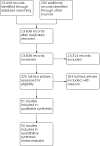
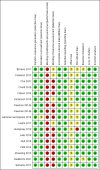
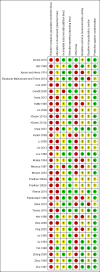
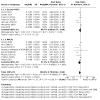
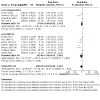


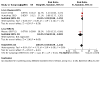

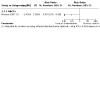
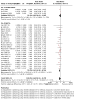
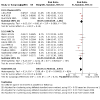
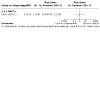
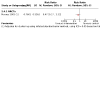
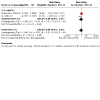
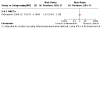
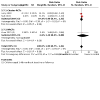
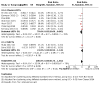
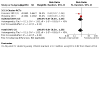
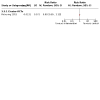
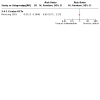

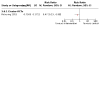
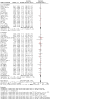
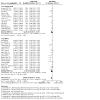
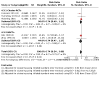
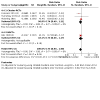
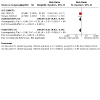
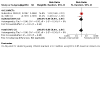
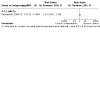
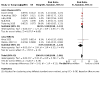
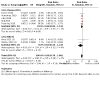
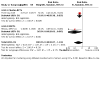
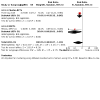

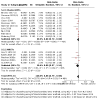

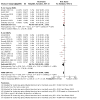
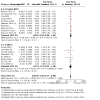
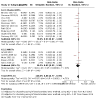
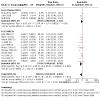

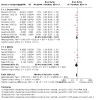
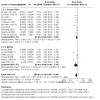





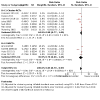
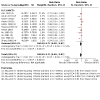
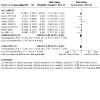
Update of
- doi: 10.1002/14651858.CD013328
Similar articles
-
Drugs for preventing postoperative nausea and vomiting in adults after general anaesthesia: a network meta-analysis.Cochrane Database Syst Rev. 2020 Oct 19;10(10):CD012859. doi: 10.1002/14651858.CD012859.pub2. Cochrane Database Syst Rev. 2020. PMID: 33075160 Free PMC article.
-
Systemic pharmacological treatments for chronic plaque psoriasis: a network meta-analysis.Cochrane Database Syst Rev. 2017 Dec 22;12(12):CD011535. doi: 10.1002/14651858.CD011535.pub2. Cochrane Database Syst Rev. 2017. Update in: Cochrane Database Syst Rev. 2020 Jan 9;1:CD011535. doi: 10.1002/14651858.CD011535.pub3. PMID: 29271481 Free PMC article. Updated.
-
Interventions to improve water quality for preventing diarrhoea.Cochrane Database Syst Rev. 2015 Oct 20;2015(10):CD004794. doi: 10.1002/14651858.CD004794.pub3. Cochrane Database Syst Rev. 2015. PMID: 26488938 Free PMC article.
-
Systemic pharmacological treatments for chronic plaque psoriasis: a network meta-analysis.Cochrane Database Syst Rev. 2021 Apr 19;4(4):CD011535. doi: 10.1002/14651858.CD011535.pub4. Cochrane Database Syst Rev. 2021. Update in: Cochrane Database Syst Rev. 2022 May 23;5:CD011535. doi: 10.1002/14651858.CD011535.pub5. PMID: 33871055 Free PMC article. Updated.
-
Integrated management of childhood illness (IMCI) strategy for children under five.Cochrane Database Syst Rev. 2016 Jun 22;2016(6):CD010123. doi: 10.1002/14651858.CD010123.pub2. Cochrane Database Syst Rev. 2016. PMID: 27378094 Free PMC article.
Cited by
-
Epidemiology of Rotavirus in Humans, Animals, and the Environment in Africa: A Systematic Review and Meta-analysis.J Infect Dis. 2024 May 15;229(5):1470-1480. doi: 10.1093/infdis/jiad500. J Infect Dis. 2024. PMID: 37962924 Free PMC article.
-
Diarrhoeal outcomes in young children depend on diarrhoeal cases of other household members: a cross-sectional study of 16,025 people in rural Uganda.BMC Infect Dis. 2022 May 21;22(1):484. doi: 10.1186/s12879-022-07468-2. BMC Infect Dis. 2022. PMID: 35597899 Free PMC article.
-
Prevalence and risk factors of acute respiratory infection and diarrhea among children under 5 years old in low-middle wealth household, Indonesia.Infect Dis Poverty. 2025 Feb 27;14(1):13. doi: 10.1186/s40249-025-01286-9. Infect Dis Poverty. 2025. PMID: 40016855 Free PMC article.
-
Systematic Evaluation of How Indicators of Inequity and Disadvantage Are Measured and Reported in Population Health Evidence Syntheses.Int J Environ Res Public Health. 2025 May 29;22(6):851. doi: 10.3390/ijerph22060851. Int J Environ Res Public Health. 2025. PMID: 40566278 Free PMC article. Review.
-
Open defecation free status and its determinants in rural Uganda: a cross-sectional survey.BMC Public Health. 2025 May 28;25(1):1974. doi: 10.1186/s12889-025-23208-y. BMC Public Health. 2025. PMID: 40437400 Free PMC article.
References
References to studies included in this review
Arnold 2010 {published data only}
Aziz 1990 {published data only}
-
- Aziz KM, Hoque BA, Hasan KZ, Patwary MY, Huttly SR, Rahaman MM, et al. Reduction in diarrhoeal diseases in children in rural Bangladesh by environmental and behavioural modifications. Transactions of the Royal Society of Tropical Medicine and Hygiene 1990;84(3):433-8. - PubMed
Azurin 1974 {published data only}
Boubacar Maïnassara 2014 {published data only}
Briceno 2017 {published data only}
Cameron 2013 {published data only}
-
- Cameron L, Shah M, Olivia S. Impact evaluation of a large-scale rural sanitation project in Indonesia. 2013. Policy Research Working Paper; No. 6360. World Bank, Washington, DC. openknowledge.worldbank.org/handle/10986/13166 (accessed 18 June 2019).
Cao 2007 {published data only}
-
- Cao DQ, Zhang R. Investigation of water and latrine improvement intervention of diarrhea disease control in rural areas. Zhong Guo Nong Cun Wei Sheng Shi Ye Guan Li [Chinese Rural Health Service Administration] 2007;27(6):466-7.
Cha 2021 {published data only}
-
- Cha S, Jung S, Bizuneh DB, Abera T, Doh YA, Seong J, et al. Effect of a community-led total sanitation intervention on the incidence and prevalence of diarrhea in children in rural Ethiopia: a cluster-randomized controlled trial. American Journal of Tropical Medicine and Hygiene 2021;105(2):532-43. - PMC - PubMed
Chard 2019 {published data only}
-
- Chard AN, Garn JV, Chang HH, Clasen T, Freeman MC. Impact of a school-based water, sanitation, and hygiene intervention on school absence, diarrhea, respiratory infection, and soil-transmitted helminths: results from the WASH HELPS cluster-randomized trial. Journal of Global Health 2019;9(2):020402. - PMC - PubMed
Clasen 2014 {published data only}
-
- Clasen T, Boisson S, Routray P, Torondel B, Bell M, Cumming O, et al. Effectiveness of a rural sanitation programme on diarrhoea, soil-transmitted helminth infection, and child malnutrition in Odisha, India: a cluster-randomised trial. Lancet Global Health 2014;2(11):e645-53. - PubMed
Dickinson 2015 {published data only}
-
- Dickinson KL, Patil SR, Pattanayak SK, Poulos C, Yang JH. Nature’s call: impacts of sanitation choices in Orissa, India. Economic Development and Cultural Change 2015;64:1-29.
Freeman 2014a {published data only}
Freeman 2014b {published data only}
Garrett 2008 {published data only}
Hammer 2016 {published data only}
Hashi 2017 {published data only}
Huda 2012 {published data only}
-
- Huda TM, Unicomb L, Johnston RB, Halder AK, Yushuf Sharker MA, Luby SP. Interim evaluation of a large scale sanitation, hygiene and water improvement programme on childhood diarrhea and respiratory disease in rural Bangladesh. Social Science & Medicine 2012;75(4):604-11. - PubMed
Humphrey 2019 {published data only}
-
- Humphrey JH, Mbuya MNN, Ntozini R, Moulton LH, Stoltzfus RJ, Tavengwa NV, et al. Independent and combined effects of improved water, sanitation, and hygiene, and improved complementary feeding, on child stunting and anaemia in rural Zimbabwe: a cluster-randomised trial. Lancet Global Health 2019;7(1):e132-47. - PMC - PubMed
Huttly 1990 {published data only}
-
- Huttly SR, Blum D, Kirkwood BR, Emeh RN, Okeke N, Ajala M, et al. The Imo State (Nigeria) Drinking Water Supply and Sanitation Project, 2. Impact on dracunculiasis, diarrhoea and nutritional status. Transactions of the Royal Society of Tropical Medicine and Hygiene 1990;84(2):316-21. - PubMed
Jin 2009 {published data only}
-
- Jin LJ, Zhang CY, Yang L, Zhang ZF, Sun L, Zhu HB, et al. Water supply and latrine improvement and prevention of diarrheal diseases in rural areas in Sichuan Province. Huan Jing Yu Jian Kang Za Zhi [Journal of Environmental Health] 2009;26(1):56-8.
Klasen 2012a {published data only}
-
- Klasen S, Lechtenfeld T, Meier K, Rieckmann J. Benefits trickling away: the health impact of extending access to piped water and sanitation in urban Yemen. Journal of Development Effectiveness 2012;4(4):537-65.
Klasen 2012b {published data only}
-
- Klasen S, Lechtenfeld T, Meier K, Rieckmann J. Benefits trickling away: the health impact of extending access to piped water and sanitation in urban Yemen. Journal of Development Effectiveness 2012;4(4):537-65.
Knee 2021 {published data only}
-
- Brown J, Cumming O, Bartram J, Cairncross S, Ensink J, Holcomb D, et al. A controlled, before-and-after trial of an urban sanitation intervention to reduce enteric infections in children: research protocol for the Maputo Sanitation (MapSan) study, Mozambique. BMJ Open 2015;5(6):e008215. - PMC - PubMed
Kolahi 2009 {published data only}
-
- Kolahi AA, Rastegarpour A, Sohrabi MR. The impact of an urban sewerage system on childhood diarrhoea in Tehran, Iran: a concurrent control field trial. Transactions of the Royal Society of Tropical Medicine and Hygiene 2009;103(5):500-5. - PubMed
Li 2009 {published data only}
-
- Li ZC, Liu HC, Chen J, Huang XJ. Evaluation of effect of improved latrines in rural areas of Chengdu. Ji Bing Jian Ce Yu Kong Zhi Za Zhi [Journal of Diseases Monitor and Control] 2009;3(3):135-6.
Lin 2013 {published data only}
-
- Lin Y, Shen ZM, Jiang WP, Zhou WL. Study on the effect of hygiene intervention measures on diarrheal diseases in the rural areas of Jiaxing City. Shi Yong Yu Fang Yi Xue [Practical Preventive Medicine] 2013;20(11):1343-5.
Lou 1989 {published data only}
-
- Lou H, Liu XM, Song SM, Li QM, Zhang WP, Xu GX, et al. Evaluating the effects of diarrhea disease control and associated economic benefits by intervention measure to improve environmental hygiene in rural villages. He Nan Wei Sheng Fang Yi [Henan Health and Disease Control] 1989;1:25-9.
Luby 2018 {published data only}
Mcabe 1954 {published data only}
Messou 1997 {published data only}
-
- Messou E, Sangaré SV, Josseran R, Le Corre C, Guélain J. Effect of hygiene measures, water sanitation and oral rehydration therapy on diarrhea in children less than five years old in the south of Ivory Coast. Bulletin de la Société de Pathologie Exotique 1997;90(1):44-7. - PubMed
Moraes 2003 {published data only}
-
- Moraes LR, Cancio JA, Cairncross S, Huttly S. Impact of drainage and sewerage on diarrhoea in poor urban areas in Salvador, Brazil. Transactions of the Royal Society of Tropical Medicine and Hygiene 2003;97(2):153-8. - PubMed
Null 2018 {published data only}
Patil 2014 {published data only}
Pickering 2015 {published data only}
-
- Pickering AJ, Djebbari H, Lopez C, Coulibaly M, Alzua ML. Effect of a community-led sanitation intervention on child diarrhoea and child growth in rural Mali: a cluster-randomised controlled trial. Lancet Global Health 2015;3(11):e701-11. - PubMed
Pradhan 2002a {published data only}
-
- Pradhan M, Rawlings LB. The impact and targeting of social infrastructure investments: lessons from the Nicaraguan Social Fund. World Bank Economic Review 2002;16(2):275-95.
Pradhan 2002b {published data only}
-
- Pradhan M, Rawlings LB. The impact and targeting of social infrastructure investments: lessons from the Nicaraguan Social Fund. World Bank Economic Review 2002;16(2):275-95.
Quattrochi 2021 {published data only}
-
- Quattrochi JP, Coville A, Mvukiyehe E, Dohou CJ, Esu F, Cohen B, et al. Effects of a community-driven water, sanitation and hygiene intervention on water and sanitation infrastructure, access, behaviour, and governance: a cluster-randomised controlled trial in rural Democratic Republic of Congo. BMJ Global Health 2021;6(5):e005030. - PMC - PubMed
Reese 2019 {published data only}
-
- Reese H, Routray P, Torondel B, Sinharoy SS, Mishra S, Freeman MC, et al. Assessing longer-term effectiveness of a combined household-level piped water and sanitation intervention on child diarrhoea, acute respiratory infection, soil-transmitted helminth infection and nutritional status: a matched cohort study in rural Odisha, India. International Journal of Epidemiology 2019;48(6):1757-67. - PMC - PubMed
Rubenstein 1969 {published data only}
Saha 2015 {published data only}
Sinharoy 2017 {published data only}
Trinies 2016 {published data only}
Wei 1998 {published data only}
-
- Wei XN, Shao BC, Fang CH, Gao M, Zhu XL. Assessment of effects of diarrhea and roundworm disease prevention by intervention measures of school environmental hygiene in rural areas. Zhong Guo Gong Gong Wei Sheng [China Public Health] 1998;14(4):228.
Wen 2005 {published data only}
-
- Wen ZK, Yang Y, Wu CY. Economic and social benefit analysis of improvement of latrines in countryside of Hunan Province, China. Huang Jing Yu Jiang Kang Za Zhi [Journal of Environment and Health] 2005;22(6):445-7.
Xing 2002 {published data only}
-
- Xing L, Si HX, Wang JR. Investigation of diarrhea disease prevention and control. Zhi Ye Yu Jian Kang [Occupation and Health] 2002;18(8):87-8.
Xu 1990 {published data only}
-
- Xu JZ. Observation on the efficacy of three squares septic tank lavatory for disease prevention. Huan Jing Yu Jian Kang Za Zhi [Journal of Environment and Health] 1990;1990:250-2.
Xu 1994 {published data only}
-
- Xu GX, Zhu XL. The assessment of the effects for prevention of diseases by non-hazardous treatment of night soil at experimental spots in rural areas. Wei Sheng Yan Jiu [Journal of Hygiene Research] 1994;23(1):23-7.
Yan 1986 {published data only}
-
- Yan ZS, Wang GF, Cui C, Yin LS, Su CH, Liu F, et al. Observation of effects on diarrhea prevention and fly density reduction via double vault funnel latrines. He Nan Wei Sheng Fang Yi [Henan Health and Disease Control] 1986;3:73-6.
Zhang 2000 {published data only}
-
- Zhang WP, Liu MX, Yin WH, Zhang HJ, Li GF, Liu LP, et al. Evaluation of a long-term effect on improving drinking water and lavatories in rural areas for prevention of diseases. Ji Bing Kong Zhi Za Zhi [Chinese Journal of Disease Control and Prevention] 2000;4(1):76-8.
Zhou 1995 {published data only}
-
- Zhou YT, Wang ZS, Gu BK, Tan JD, Su ZL, Fan P-H. Evaluation and cost effectiveness analysis of strategies to manage feces and control diarrhea disease. Shang Hai Yu Fang Yi Xue [Shanghai Journal of Preventive Medicine] 1995;7(9):388-91.
Zhu 1997 {published data only}
-
- Zhu XL, Xia QY, Meng ZY, Wang XC, Shao BC, Yang SY, Shang Q. Assessment of effects of disease prevention by intervention measures of school environmental hygiene in rural areas. Wei Sheng Yan Jiu [Journal of Hygiene Research] 1997;26(6):378-80.
References to studies excluded from this review
Aiga 1999 {published data only}
Altmann 2018 {published data only}
-
- Altmann M, Altare C, Spek N, Barbiche JC, Dodos J, Bechir M, et al. Effectiveness of a household water, sanitation and hygiene package on an outpatient program for severe acute malnutrition: a pragmatic cluster-randomized controlled trial in Chad. American Journal of Tropical Medicine and Hygiene 2018;98(4):1005-12. - PMC - PubMed
Aw 2019 {published data only}
Benjamin‐Chung 2018 {published data only}
Burström 2005 {published data only}
Butala 2010 {published data only}
-
- Butala NM, VanRooyen MJ, Patel RB. Improved health outcomes in urban slums through infrastructure upgrading. Social Science & Medicine 2010;71(5):935-40. - PubMed
Dreibelbis 2014 {published data only}
el Gaddal 1985 {published data only}
-
- el Gaddal AA. The Blue Nile Health Project: a comprehensive approach to the prevention and control of water-associated diseases in irrigated schemes of the Sudan. Journal of Tropical Medicine and Hygiene 1985;88(2):47-56. - PubMed
Ercumen 2018 {published data only}
-
- Ercumen A, Mertens A, Arnold BF, Benjamin-Chung J, Hubbard AE, Ahmed MA, et al. Effects of single and combined water, sanitation and handwashing interventions on fecal contamination in the domestic environment: a cluster-randomized controlled trial in rural Bangladesh. Environmental Science & Technology 2018;52(21):12078-88. - PMC - PubMed
Fang 1992 {published data only}
-
- Fang HS, Guo PH, Wang JX, Jia M. Investigation on health education and prevention of child diarrhea diseases. Zhong Guo Fu You Bao Jian [Maternal and Child Health Care of China] 1992;7(1):37-46.
Garn 2016 {published data only}
George 2016 {published data only}
Godfrey 2014 {published data only}
-
- Godfrey S, Van der Velden M, Muianga A, Vigh M, Gunning JW, Elbers C. Impact study of the One Million Initiative rural water and sanitation programme in Mozambique. Waterlines 2014;33(1):35-44.
Johansen 2015 {published data only}
Kmietowicz 2014 {published data only}
-
- Kmietowicz Z. More toilets in India did not improve health, finds study. BMJ 2014;349:g6169. - PubMed
Linquist 2014 {published data only}
-
- Lindquist ED, George CM, Perin J, Neiswender de Calani KJ, Norman WR, Davis TP, et al. A cluster randomized controlled trial to reduce childhood diarrhea using hollow fiber water filter and/or hygiene–sanitation educational interventions. American Journal of Tropical Medicine and Hygiene 2014;91(1):190-7. - PMC - PubMed
Morse 2020 {published data only}
Nery 2015 {published data only}
-
- Nery SV, McCarthy JS, Traub R, Andrews RM, Black J, Gray D, et al. A cluster-randomised controlled trial integrating a community-based water, sanitation and hygiene programme, with mass distribution of albendazole to reduce intestinal parasites in Timor-Leste: the WASH for WORMS research protocol. BMJ Open 2015;5(12):e009293. - PMC - PubMed
Overgaard 2016 {published data only}
Rasella 2013 {published data only}
-
- Rasella D. Impact of the Water for All Program (PAT) on childhood morbidity and mortality from diarrhea in the Bahia State, Brazil [Impacto do Programa Água para Todos (PAT) sobre a morbi-mortalidade por diarreia em crianças do Estado da Bahia, Brasil]. Cadernos de Saude Publica 2013;29(1):40-50. - PubMed
Vally 2019 {published data only}
Walker 1999 {published data only}
-
- Walker I, Cid R, Ordoñez F, Rodríguez F. Ex-post evaluation of the Honduran social investment fund (FHIS 2). 1999. ghdx.healthdata.org/record/ex-post-evaluation-honduran-social-investment... (accessed 21 June 2019).
Xiao 1997 {published data only}
-
- Xiao S, Lin C, Chen K. Evaluation of effectiveness of comprehensive control for diarrhea diseases in rural areas of east Fujian and analysis of its cost-benefit. Zhonghua Yu Fang Yi Xue Za Zhi [Chinese Journal of Preventive Medicine] 1997;31(1):40-1. - PubMed
References to ongoing studies
Cha 2017 {published data only}
-
- ISRCTN82492848. The impact of improved sanitation on the diarrhoeal reduction of under-five children in Ethiopia. isrctn.com/ISRCTN82492848 (first received 22 January 2015).
Dockx 2019 {published data only}
-
- Dockx K, Van Remoortel H, De Buck E, Schelstraete C, Vanderheyden A, Lievens T, et al. Effect of contextualized versus non-contextualized interventions for improving hand washing, sanitation, and health in rural Tanzania: study design of a cluster randomized controlled trial. International Journal of Environmental Research and Public Health 2019;16(14):2529. - PMC - PubMed
-
- NCT03709368. Software interventions for improving hand washing and sanitation in rural Tanzania: an impact evaluation [Effect of two add-on software interventions for improving hand washing and sanitation in rural Tanzania: an impact evaluation]. clinicaltrials.gov/ct2/show/NCT03709368 (first received 17 October 2018).
NCT03594279 {published data only}
-
- NCT03594279. Community mobilization and incentivization for childhood diarrhea and pneumonia (CoMIC) [Evaluation of a community engagement and demand creation strategy for childhood diarrhea and pneumonia in Pakistan]. clinicaltrials.gov/ct2/show/NCT03594279 (first received 20 July 2018).
Raso 2018 {published data only}
-
- ISRCTN53102033. An integrated approach to fight parasitic worms and diarrhoea [An integrated approach to fight neglected tropical diseases and diarrhoea]. isrctn.com/ISRCTN53102033 (first received 24 February 2014).
Additional references
Bethony 2006
-
- Bethony J, Brooker S, Albonico M, Geiger SM, Loukas A, Diemert D, et al. Soil-transmitted helminth infections: ascariasis, trichuriasis, and hookworm. Lancet 2006;367(9521):1521-32. - PubMed
Checkley 2008
Clasen 2015
Cochrane Community 2018
-
- Cochrane Community. Glossary. community.cochrane.org/glossary (accessed 10 December 2018).
Cochrane EPOC 2017
-
- Cochrane Effective Practice and Organisation of Care. Suggested risk of bias criteria for EPOC reviews. 2017. epoc.cochrane.org/sites/epoc.cochrane.org/files/public/uploads/Resources... (accessed 10 December 2018).
Cochrane EPOC 2019
-
- Cochrane Effective Practice and Organisation of Care. What study designs should be included in an EPOC review and what should they be called? https://epoc.cochrane.org/sites/epoc.cochrane.org/files/public/uploads/E... (accessed 29 May 2019).
Ejemot‐Nwadiaro 2021
Feachem 1983
-
- Feachem RG, Bradley DJ, Garelick H, Mara DD. Sanitation and Disease. Health Aspects of Wastewater and Excreta Management. World Bank Studies in Water Supply and Sanitation. Vol. 3. Chichester (UK): John Wiley & Sons, 1983.
Fischer Walker 2012
Freeman 2017
-
- Freeman MC, Garn JV, Sclar GD, Boisson S, Medlicott K, Alexander KT, et al. The impact of sanitation on infectious disease and nutritional status: a systematic review and meta-analysis. International Journal of Hygiene and Environmental Health 2017;220(6):928-49. - PubMed
GBD 2020
Guerrant 2012
Guyatt 2011
-
- Guyatt G, Oxman AD, Akl EA, Kunz R, Vist G, Brozek J, et al. GRADE Guidelines: 1. Introduction - GRADE evidence profiles and summary of findings tables. Journal of Clinical Epidemiology 2011;64(4):383-94. - PubMed
Higgins 2011
Humphrey 2009
-
- Humphrey JH. Child undernutrition, tropical enteropathy, toilets, and handwashing. Lancet 2009;374(9694):1032-5. - PubMed
IHME 2019
-
- Institute for Health Metrics and Evaluation. GBD results tool. https://vizhub.healthdata.org/gbd-results/ (accessed 24 September 2021).
Korpe 2012
Kotloff 2013
-
- Kotloff KL, Nataro JP, Blackwelder WC, Nasrin D, Farag TH, Panchalingam S, et al. Burden and aetiology of diarrhoeal disease in infants and young children in developing countries (the Global Enteric Multicenter Study, GEMS): a prospective, case-control study. Lancet 2013;382(9888):209-22. - PubMed
Lefebvre 2011
-
- Lefebvre C, Manheimer E, Glanville J. Chapter 6: Searching for studies. In: Higgins JP, Green S, editor(s). Cochrane Handbook for Systematic Reviews of Interventions Version 5.1.0 (updated March 2011). The Cochrane Collaboration, 2011. Available from handbook.cochrane.org.
Majorin 2019
Murad 2017
-
- Murad MH, Almasri J, Alsawas M, Farah W. Grading the quality of evidence in complex interventions: a guide for evidence-based practitioners. BMJ Evidence-Based Medicine 2017;22(1):20-2. - PubMed
Norman 2010
-
- Norman G, Pedley S, Takkouche B. Effects of sewerage on diarrhoea and enteric infections: a systematic review and meta-analysis. Lancet Infectious Diseases 2010;10(8):536-44. - PubMed
Penakalapati 2017
Pickering 2019
-
- Pickering AJ, Null C, Winch PJ, Mangwadu G, Arnold BF, Prendergast AJ, et al. The WASH Benefits and SHINE trials: interpretation of WASH intervention effects on linear growth and diarrhoea. Lancet Global Health 2019;7(8):e1139-46. - PubMed
Platts‐Mills 2015
RevMan 2020 [Computer program]
-
- Review Manager 5 (RevMan 5). Version 5.4. Copenhagen: The Cochrane Collaboration, 2020.
Sania 2019
Sclar 2017
-
- Sclar GD, Garn JV, Penakalapati G, Alexander KT, Krauss J, Freeman MC, et al. Effects of sanitation on cognitive development and school absence: a systematic review. International Journal of Hygiene and Environmental Health 2017;220(6):917-27. - PubMed
Stelmach 2015
Troeger 2018
-
- Troeger C, Blacker BF, Khalil IA, Rao PC, Cao S, Zimsen SRM, et al. Estimates of the global, regional, and national morbidity, mortality, and aetiologies of diarrhoea in 195 countries: a systematic analysis for the Global Burden of Disease Study 2016. Lancet Infectious Diseases 2018;18(11):1211-28. - PMC - PubMed
Waddington 2009
-
- Waddington H, Snilstveit B, White H, Fewtrell L. Water, sanitation and hygiene interventions to combat childhood diarrhoea in developing countries. August 2009. Delhi: International Initiative for Impact Evaluation. 3ieimpact.org/sites/default/files/2019-01/sr1-WASH.pdf.
WHO/UNICEF 2015
-
- WHO/UNICEF. Progress on sanitation and drinking water – 2015 update and MDG assessment. Available at unicef.org/reports/progress-sanitation-and-drinking-water (accessed 16 August 2018).
WHO/UNICEF 2017
-
- WHO/UNICEF. Progress on drinking water, sanitation and hygiene: 2017 update and SDG baselines. Available at washdata.org/sites/default/files/documents/reports/2019-05/JMP-2017-repo... (accessed 16 August 2018).
WHO/UNICEF 2021
-
- WHO/UNICEF Joint Monitoring Programme for Water Supply, Sanitation and Hygiene. Progress on household drinking water, sanitation and hygiene 2000-2020: five years into the SDGs. 13 September 2021. Available at who.int/publications/i/item/9789240030848.
WHO 1993
-
- World Health Organization. The management and prevention of diarrhoea. Practical guidelines. 3rd edition. apps.who.int/iris/bitstream/handle/10665/37036/9241544546_eng.pdf?sequen... (accessed 29 March 2018).
WHO 2017
-
- World Health Organization. Diarrhoeal disease fact sheet. 2 May 2017. www.who.int/mediacentre/factsheets/fs330/en/ (accessed 29 March 2018).
WHO 2020
-
- World Health Organization. The top 10 causes of death. who.int/mediacentre/factsheets/fs310/en/ (accessed 15 September 2021).
Wolf 2018
-
- Wolf J, Hunter PR, Freeman MC, Cumming O, Clasen T, Bartram J, et al. Impact of drinking water, sanitation and handwashing with soap on childhood diarrhoeal disease: updated meta‐analysis and meta‐regression. Tropical Medicine & International Health 2018;23(5):508-25. - PubMed
References to other published versions of this review
Bauza 2019
Publication types
MeSH terms
Grants and funding
LinkOut - more resources
Full Text Sources
Research Materials
Miscellaneous

